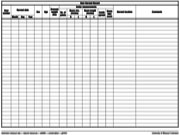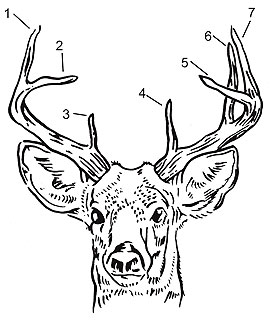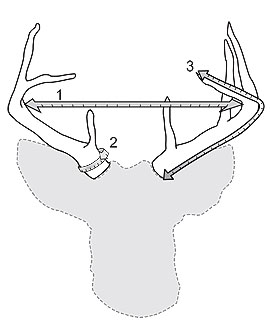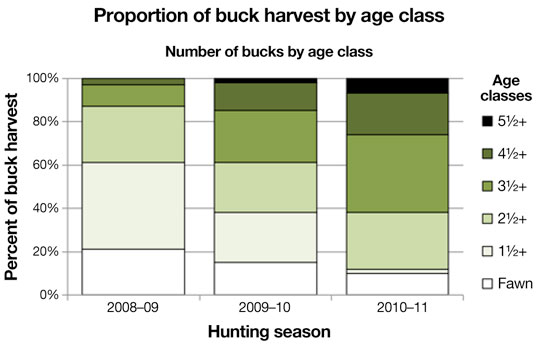Deer populations in most of rural Missouri are controlled by harvest. Therefore, the number of deer taken during the hunting seasons affects the population size, both regionally and locally. Most Missouri counties have liberal bag limits for antlerless deer, but because hunting pressure and deer numbers on properties vary widely, making deer harvest decisions for your property based only on county deer regulations can produce unwanted results.
Because harvest has such a significant effect on deer population size, harvest data can reveal much information about the local deer population and help managers make sound deer-management decisions. However, harvest data must be collected carefully and consistently; collect the data from each deer harvested and in the same manner every time.
When making sex-specific harvest recommendations, you will need information on deer harvested the previous two or three years. By comparing harvest and observational data over a number of years, you can evaluate the effectiveness of harvest recommendations in meeting management objectives.
Harvest data to collect
Your specific management objectives will largely dictate the amount of information needed for decision making and evaluations. However, at a minimum, record the following information for each deer harvested:
- Deer identification number
- Date of harvest
- Sex
- Weight
- Age
- Location
For antlered bucks, also collect the following information:
- Number of points
- Antler spread
- Beam circumference
- Beam length
Additional data such as lactation of does and fetal counts can be collected but may require additional effort or special equipment.
 Figure 1. Sample deer harvest record PDF
Figure 1. Sample deer harvest record PDF
Deer identification number
A deer identification number is assigned to each deer harvested. Inclusion of the year in the ID number (for example, 2011-01) allows for easier sorting of deer by harvest year.
Sex
The physical characteristics of deer are largely sex-specific, so noting the number of males and females is important.
Weight
Deer weight provides an important index of the condition of the deer herd. This is especially true of fawn and yearling body weights because their rapidly growing bodies are the most sensitive to changes in environmental conditions.
Monitoring changes over time in sex-specific fawn and yearling body weights can be indicative of changes in population size or habitat conditions. Adult buck weight is not a good indicator because bucks harvested later in the breeding season may have lost substantial body weight.
Dressed weights are used because live weights can be inconsistent due to stomach contents. An animal can weigh significantly more with a full rumen than it would with an empty rumen.
A good set of scales, periodically recalibrated, is a useful tool to have.
Age
Age may be the most important data used to evaluate the success of a deer management program. Without age estimates, the rest of the data may not be useful.
Many deer management objectives are geared toward increasing antler size, improving buck age structure and maintaining appropriate adult sex ratios. Age determination is critical to quantifying management success for these objectives.
Age is determined by evaluating patterns of tooth replacement and wear on the lower jaw. The lower jaw must be removed for aging. See MU Extension publication G9484, Aging a Deer by Examining Its Jawbone, for methods of jaw removal and aging.
Age deer when collecting all other data, or attach a tag with the Deer ID number on each jawbone and age all jawbones collected throughout the season at a later date. Greater accuracy and consistency can be obtained by aging all jawbones at one time.
In most situations, managers need to place harvested deer into only three age classes: fawns (6 months old), yearlings (1-1/2 years old) and adults (2-1/2+ years old). For more intensive management programs, placing individuals in more specific older-age classes maybe useful but accuracy of the tooth-replacement-and-wear method beyond 3-1/2 years of age is more difficult. The cementum annuli technique is more accurate at aging adult deer than tooth replacement and wear, but for most managers that level of detail is unnecessary.
Antler characteristics
Understanding site-specific antler characteristics is important when establishing antler-based harvest criteria. Figure 2a shows how to count antler points. Figure 2b shows how to measure other antler characteristics. For consistency, make all measurements to the nearest eighth of an inch.
Number of antler points should be relatively straightforward, but there tends to be inconsistency in what is considered a point. To ensure consistency, count only points that are 1 inch or longer. (See Figure 2a.)
Inside spread is measured at a right angle to the center line of the skull at the widest point between main beams.
Basal circumference can be measured either at the narrowest point between the burr and the brow tine, or one inch above the burr. Although both methods work, choose one and use it consistently when collecting data.
Main beam length is measured along the center line on the outer edge of the main beam from the burr to the tip.
Additional antler measurements such as tine length and circumferences can be recorded but are not necessary.
 Figure 2a. When counting antler points, consistently count only points that are at least 1 inch long. This rack has seven points.
Figure 2a. When counting antler points, consistently count only points that are at least 1 inch long. This rack has seven points.
 Figure 2b. Record these three antler measurements for each buck harvested: (1) inside spread, (2) basal circumference and (3) main beam length.
Figure 2b. Record these three antler measurements for each buck harvested: (1) inside spread, (2) basal circumference and (3) main beam length.
Harvest location
Harvest location can be helpful in determining the productivity on different properties, as well as monitoring the intensity of pressure placed on bucks and does in a given area. This information is especially important when dealing with large areas or multiple landowners.
Comments
Use the comments section to record any unusual observations about the deer harvested, such as broken antler points or beams; the weather conditions; and other items of interest associated with the events leading up to the harvest.
Optional data
In other regions of the country, data on lactation and on fetal counts and aging are commonly collected. In Missouri, however, this data may be unnecessary or difficult to collect and is optional.
Lactation
The presence of milk indicates that a doe gave birth and successfully raised one or more fawns. The percentage of adult does lactating in a given year is indicative of the health of the population.
The lactation rate of yearling does provides important information on the overall condition of the deer herd. High lactation rates in yearling does is indicative of high fawn reproduction. Yearling does were fawns at the time of conception, and for fawns to successfully reproduce, a population must be in balance with the habitat and high-quality nutrition must be present.
To check for lactation, simply squeeze the doe’s mammary glands. Does that gave birth early or weaned fawns early may be recorded incorrectly as “dry.” To verify lactation, you may need to slice into the milk bag; the presence of a yellowish to brown material means the doe had recently been producing milk and, therefore, should not be marked as “dry.”
Fetal counts and aging
Fetal data is collected to estimate breeding dates and reproductive rates. If fetuses are present, they can be removed and aged by measuring crown-rump length on a fetal aging scale (available from the Quality Deer Management Association, http://www.qdma.com, or Forestry Suppliers Inc., http://www.forestry-suppliers.com).
Generally, fetuses must be 30 to 40 days to be measurable. Fetal ages can then be backdated from the date of harvest to determine conception date. However, with the timing of the deer season, the only period when measurable fetuses may be present in harvested does will be during late-December or early-January hunts.
Fetal counts for adult does will be high for nearly all regions of the state. Fawn reproduction can be an indicator of overall conditions of the herd. In most situations, however, fawn breeding will not be detected in deer harvested during the regular hunting season.
Use of harvest data
Harvest data can be used to make management decisions and improve the quality of a deer herd on a property. In this example, one of the quality deer management (QDM) objectives for the property was to increase the number of mature bucks over 31/2 years old. Figure 3 depicts the proportion of bucks harvested by age class during each of the three hunting seasons. As a result of management efforts, the proportion of harvested bucks in the older age classes increased.
 Figure 3. This harvest data graph suggests management efforts on this property are increasing the age structure of the buck harvest, essentially allowing more mature bucks to be available for harvest.
Figure 3. This harvest data graph suggests management efforts on this property are increasing the age structure of the buck harvest, essentially allowing more mature bucks to be available for harvest.